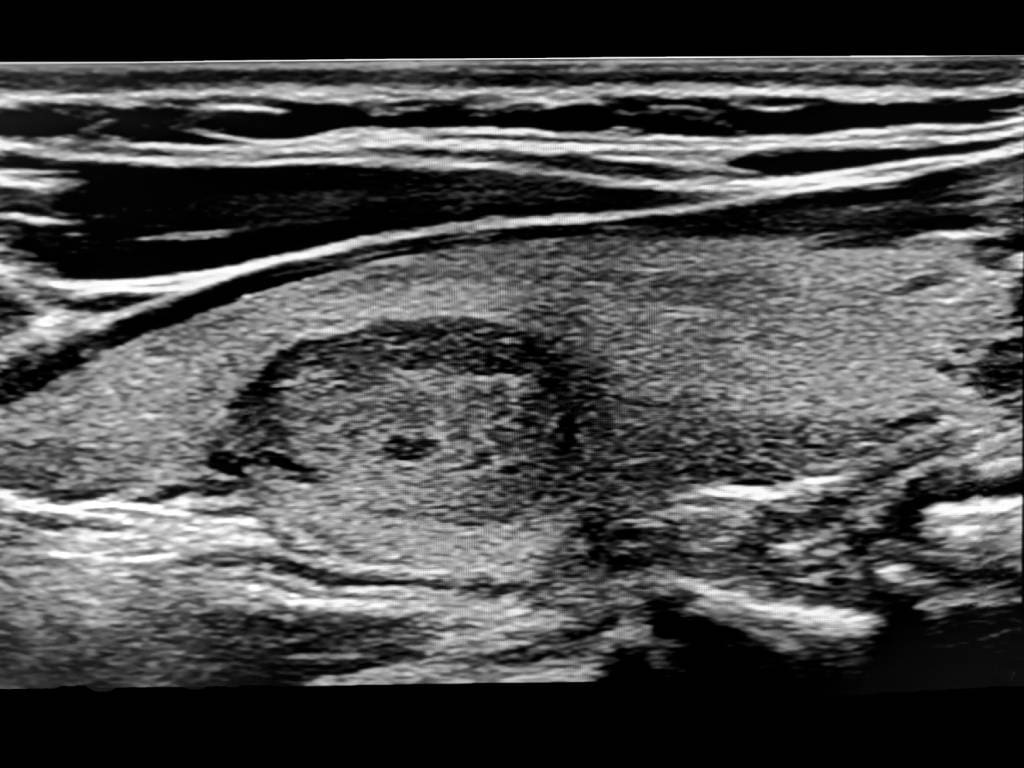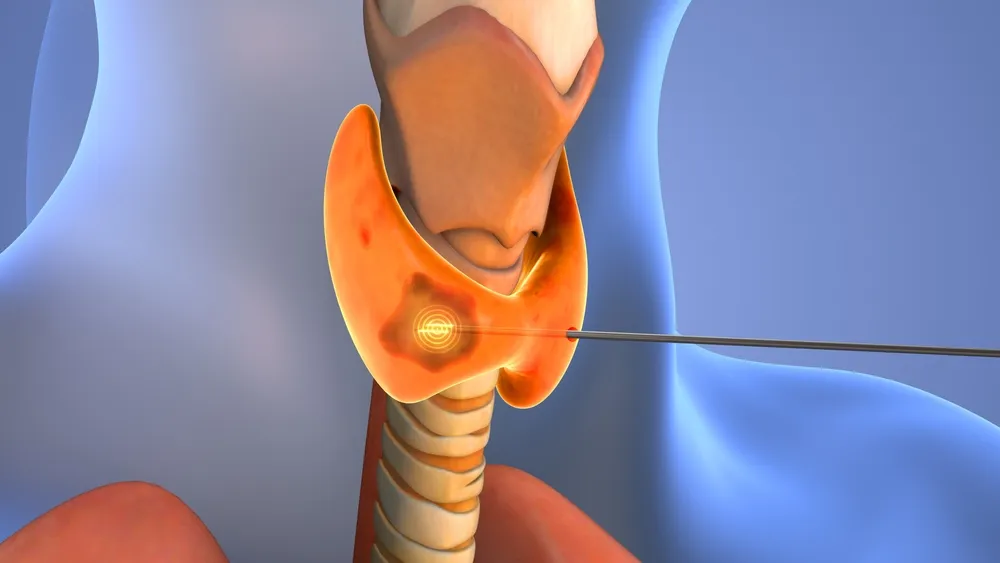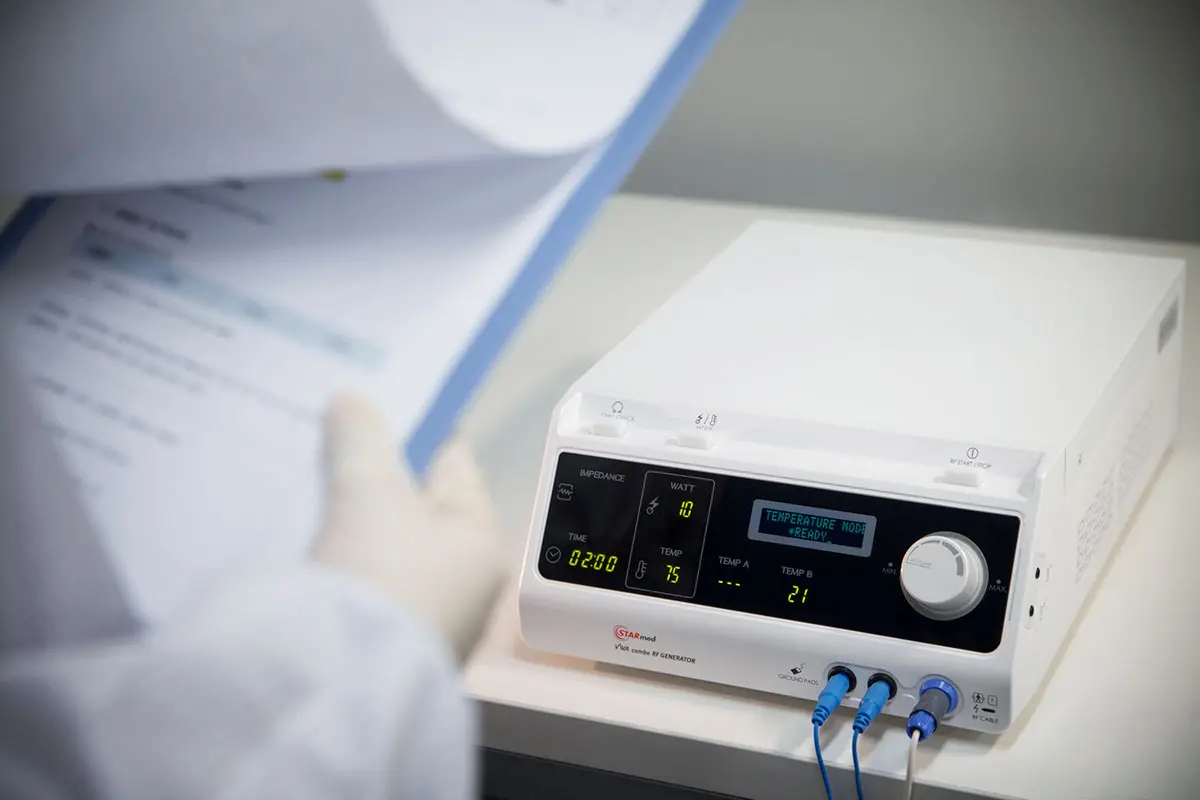Summary: Thyroid ultrasound is a critical diagnostic tool that helps visualize the thyroid gland, detect nodules, and assess their characteristics. It aids in determining whether a nodule is benign or suspicious for malignancy and plays a key role in evaluating candidates for thyroid radiofrequency ablation (RFA).
- Thyroid Ultrasound Basics: Uses sound waves to assess the thyroid’s size, shape, and internal structure.
- Identifying Nodules: Determines size, composition (solid, cystic, or mixed), echogenicity, and presence of calcifications.
- Risk Stratification: Helps distinguish benign from malignant nodules based on features like hypoechogenicity and irregular margins.
- RFA Candidate Assessment: Confirms benign characteristics and evaluates size, location, and symptom impact.
- Normal vs Abnormal Findings: Normal ultrasound shows uniform echogenicity, while suspicious nodules may have microcalcifications, irregular margins, or abnormal lymph nodes.
- Next Steps After Diagnosis: Benign but symptomatic nodules may be treated with ultrasound-guided RFA for nonsurgical intervention.
Thyroid ultrasound is a first-line imaging tool that provides real-time visualization of the thyroid’s internal structure. It can reveal the presence of thyroid nodules, which are a very frequent finding. In fact, most studies suggest that thyroid nodules affect up to 65% of the population.
Thyroid ultrasound is one tool that clinicians use to determine if a patient is a candidate for thyroid radiofrequency ablation (RFA). What does a thyroid ultrasound show about the gland and its nodules?
Ultrasound characteristics offer clues about whether a nodule is benign or suspicious for malignancy. Roughly 90–95% of thyroid nodules are benign. Thus, ultrasound-based risk stratification is essential to identify the few that may be cancerous.
In this blog, we will discuss what a thyroid ultrasound shows, as well as how to interpret normal vs abnormal findings. Plus, we’ll explore how ultrasound helps determine if a patient with a benign thyroid nodule is a candidate for RFA. Continue reading to learn more about interpreting ultrasound images of the thyroid
What Does a Thyroid Ultrasound Show?
A thyroid ultrasound uses high-frequency sound waves to produce detailed images of the thyroid gland.
An ultrasound shows the gland’s size, shape, and internal architecture. This allows physicians to detect and characterize any nodules or abnormalities in the least invasive manner possible. It clearly shows the location and number of nodules, plus the key features of each lesion.
These features include:
- Shape
- Internal composition (solid, cystic, or mixed)
- Echogenicity (how bright or dark it appears relative to normal thyroid tissue)
- Echotexture
- The presence of calcifications
- Margins (smooth or irregular)
- Vascularity
Thyroid ultrasound provides a real-time map of the gland. It can pinpoint even small nodules only a few millimeters in size that might be clinically occult.
Ultrasound also shows the relationships of a nodule to critical structures in the neck. These include the trachea, blood vessels, and nerves.
A normal thyroid ultrasound typically shows a uniformly echogenic gland with no discrete nodules. In contrast, an abnormal result may show one or more nodules or diffuse changes, such as thyroiditis.
Additionally, ultrasound can evaluate adjacent structures, including cervical lymph nodes. Detecting features of lymphadenopathy is crucial if a thyroid nodule is suspicious for cancer.
Notably, ultrasound is also used to guide fine-needle aspiration (FNA) biopsies of thyroid nodules. Ultrasound-guided FNA is the most accurate and cost-effective test to distinguish benign from malignant nodules.
What Will a Thyroid Ultrasound Show in Patients Considered for RFA?

When evaluating a patient for thyroid nodule radiofrequency ablation, what will a thyroid ultrasound show to help determine if they are a suitable candidate?
The ultrasound can confirm that the nodule in question has benign characteristics, including:
- A spongiform appearance (a spongy network of tiny cystic spaces)
- A mostly cystic nodule with comet-tail artifacts (reverberation echoes) inside
- A nodule that is isoechoic or hyperechoic (brighter than normal thyroid tissue)
- A nodule with smooth, oval contours
Thus, for a patient being considered for RFA, the imaging serves as a crucial check. Does the thyroid ultrasound appear normal vs abnormal for this nodule’s features?
If the ultrasound shows normal, benign features, the nodule is likely a good candidate for RFA, pending cytological confirmation from biopsy.
Assessing Nodule Size and Location
Another critical role of ultrasound in RFA evaluation is assessing nodule size and location. RFA is typically indicated for nodules that are causing symptoms such as:
- Neck discomfort
- Swallowing difficulty
- Cough
- Voice changes
- Cosmetic concerns due to size
Ultrasound will accurately measure the nodule’s dimensions and volume. This helps determine if the nodule is large enough to explain the patient’s symptoms. It can also help the physicians plan the route of access and how to better prepare the patients during the procedure to avoid critical structures.
Further Testing May Be Required
However, ultrasound is only one diagnostic test that should be used to determine a patient’s candidacy for RFA. According to international consensus and guidelines, RFA is reserved for benign thyroid nodules that cause symptoms or hormonal issues.
Before proceeding to ablation, the nodule’s benign nature should, at minimum, be confirmed by ultrasound-guided FNA cytology. In fact, most guidelines recommend obtaining at least two separate benign biopsy results prior to RFA.
If either the ultrasound or biopsy raises concern for malignancy, the patient would not be a candidate for RFA. Instead, surgical evaluation would be indicated.
Interpreting Normal vs Abnormal Thyroid Ultrasound Results
Correctly interpreting normal vs abnormal thyroid ultrasound results is pivotal in thyroid nodule management.
A normal thyroid ultrasound result would mean:
- The gland has a uniform echogenic texture
- There are no discrete nodules
- The ultrasound shows no features suggestive of pathology
Suspicious thyroid ultrasound results might show:
- A markedly hypoechoic nodule (darker than the surrounding thyroid), especially if solid
- Pinpoint microcalcifications within a nodule
- Irregular or microlobulated margins (or evidence that the nodule is invading beyond the thyroid capsule)
- A nodule that is taller in the anteroposterior dimension than its width (“taller-than-wide” shape on transverse view)
- Abnormal cervical lymph nodes on ultrasound in the presence of a thyroid nodule
Ultrasound Pattern Categories by Risk
According to the ATA guidelines, thyroid nodules can be stratified into five ultrasound pattern categories:
- Benign: Purely cystic nodule.
- Very low suspicion: Spongiform or mostly cystic nodule with comet-tail artifacts.
- Low suspicion: Isoechoic or hyperechoic solid nodule with smooth margins and peripheral vascularity.
- Intermediate suspicion: Hypoechoic solid nodule with smooth margins but no high-risk features.
- High suspicion: Solid hypoechoic nodule with irregular margins, microcalcifications, taller-than-wide shape, or extrathyroidal extension.
Next Steps After Ultrasound Diagnosis
If the nodule is benign but causing symptoms or growing, it may be time to consider treatment.
Ultrasound-guided radiofrequency ablation offers a nonsurgical alternative for treating benign thyroid nodules that warrant intervention. Under continuous ultrasound guidance, the RFA probe will be inserted into the nodule to ablate it. A predominantly solid nodule on ultrasound is expected to respond with a substantial volume reduction after RFA. Clinicians often observe >50% reduction in nodule volume within 6-12 months.
Are you a clinician interested in offering radiofrequency ablation in your practice? Learn more about Thyroid RFA and how STARmed America can help you find a high-quality training program.





